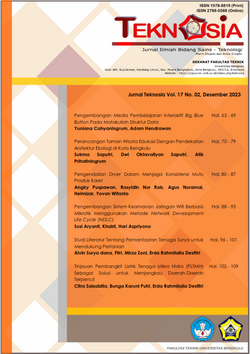Main Article Content
Abstract
The city of Bengkulu has various tourist objects both natural, cultural and artificial tourism. One of the tourist objects that has the potential to be developed and does not get more attention from the government is artificial tourism. There are still very few man-made tourist objects in the city of Bengkulu and seen from the availability of attractions, amenities and tourism accessibility that are not good in several parks that are used as green open spaces. The function of the park is not only as an object of recreation but can be developed into a tour that can educate the public. The application of ecological architecture in the design of Educational Tourism Parks is an effort to create buildings that pay attention to environmental balance while at the same time providing awareness and knowledge to the public about protecting the environment. By applying the principles of ecological architecture to the treatment of waste in buildings, the layout of the building mass, the shape of the building, and the use of materials. So that the Educational Tourism Park with an ecological architectural approach can become a place of education for all people and can minimize the impact of environmental damage.
Article Details
Copyright (c) 2023 Sukma Saputri Sukma, Dwi Oktavallyan Saputri, Atik Prihatiningrum

This work is licensed under a Creative Commons Attribution-ShareAlike 4.0 International License.
Authors who publish with this journal agree with the following terms:
- Authors retain copyright and grant the journal the right of first publication with the work simultaneously licensed under a Creative Commons Attribution License that allows others to share the work with an acknowledgement of the work's authorship and initial publication in this journal.
- Authors are able to enter into separate, additional contractual arrangements for the non-exclusive distribution of the journal's published version of the work (e.g., post it to an institutional repository or publish it in a book), with an acknowledgement of its initial publication in this journal.
- Authors are permitted and encouraged to post their work online (e.g., in institutional repositories or on their website) prior to and during the submission process, as it can lead to productive exchanges, as well as earlier and greater citation of published work (See The Effect of Open Access).
- This work is licensed under a Creative Commons Attribution-ShareAlike 4.0 International License.
References
-
Badan Pusat Statistik Provinsi Bengkulu. (2022)
Dinas Pariwisata Kota Bengkulu. (2022)
Fandeli,C. (2002). Perencanaan Kepariwisataan Alam. Fakultas Kehutanan Universitas Gajah Mada, Yogyakarta.
Frick, H., & Mulyani, T. H. (2006). Arsitektur Ekologis. Yogyakarta: Penerbit Kanisius.
Hermawan, H., Brahmanto, E., Hamzah, F., Ghani, Y. A., Somantri, P. R., & Priyanto, R. (2017). Buku panduan wisata edukasi: Program pengabdian masyarakat STP ARS Internasional. Bandung.
Masagung, A. A. P. (2019). Perancangan Edupark di Tepian Sungai Mahakam, Samarinda, Kalimantan Timur dengan Pendekatan Regionalisme Arsitektur. Skripi, Universitas Islam Indonesia,Yogyakarta.
Nasda, S. (2015). Taman Edukasi debagai Ruang Publik di Kabupaten Sinjai. Skripsi, Universitas Islam Negeri Alauddin, Makassar.
Patikaisaya, R., Ihsan, I., & Sastrawati, I. (2017). Konsep Pengembangan Wisata dan Aksesibilitas Kabupaten Bantaeng. Jurnal Wilayah & Kota Maritim (Journal of Regional and Maritime City Studies), 5(2), 140-149.
Prasetyo, L. (2018). Konsep Ekologis dan Budaya pada Perancangan Hunian Paska Bencana di Yogyakarta. Jurnal Teknik Arsitektur ARSTEKS, 2(2), 125-135.
Suharto. (2019). Minat Kunjungan Wisatawan Museum Gunungapi Merapi. Media Wisata, 17(1), 1180-1185.
Undang-Undang Republik Indonesia Nomor 10 Tahun 2009 Tentang Kepariwisataan.
References
Dinas Pariwisata Kota Bengkulu. (2022)
Fandeli,C. (2002). Perencanaan Kepariwisataan Alam. Fakultas Kehutanan Universitas Gajah Mada, Yogyakarta.
Frick, H., & Mulyani, T. H. (2006). Arsitektur Ekologis. Yogyakarta: Penerbit Kanisius.
Hermawan, H., Brahmanto, E., Hamzah, F., Ghani, Y. A., Somantri, P. R., & Priyanto, R. (2017). Buku panduan wisata edukasi: Program pengabdian masyarakat STP ARS Internasional. Bandung.
Masagung, A. A. P. (2019). Perancangan Edupark di Tepian Sungai Mahakam, Samarinda, Kalimantan Timur dengan Pendekatan Regionalisme Arsitektur. Skripi, Universitas Islam Indonesia,Yogyakarta.
Nasda, S. (2015). Taman Edukasi debagai Ruang Publik di Kabupaten Sinjai. Skripsi, Universitas Islam Negeri Alauddin, Makassar.
Patikaisaya, R., Ihsan, I., & Sastrawati, I. (2017). Konsep Pengembangan Wisata dan Aksesibilitas Kabupaten Bantaeng. Jurnal Wilayah & Kota Maritim (Journal of Regional and Maritime City Studies), 5(2), 140-149.
Prasetyo, L. (2018). Konsep Ekologis dan Budaya pada Perancangan Hunian Paska Bencana di Yogyakarta. Jurnal Teknik Arsitektur ARSTEKS, 2(2), 125-135.
Suharto. (2019). Minat Kunjungan Wisatawan Museum Gunungapi Merapi. Media Wisata, 17(1), 1180-1185.
Undang-Undang Republik Indonesia Nomor 10 Tahun 2009 Tentang Kepariwisataan.
